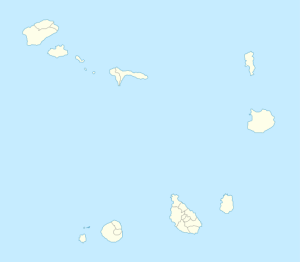It was still dark and gloomy when day broke this morning but in the course of the day the weather followed the forecast and the sun came out. Something else was put in place instead. A very long moderate swell running from the North. Thus far Africa had been acting as a wave breaker and we had been in calm seas but when we fully cleared the main land the ship started to pitch a little bit. Observing the waves rolling in, I estimated them to be about 10 to 12 feet high. With a speed of 15 knots the ship rode the waves very nicely with movements varying from almost none to a nice lift up and down. Those who had been asking for real sea days with a bit of motion of the ocean, they got their wish today.
While on the south side of the equator we were under the influence of the South Equatorial current which pushed us to the East. Now on the other side we are being pushed to the West. Courtesy of the North Equatorial Counter current. A current that is instrumental in bringing all the water back that was pushed into the North Atlantic by the Gulf Stream.
Currents produce water flow and normally also a mixture in the temperature of the sea water. Animals love that as it means that there is food. Thus there was wild life a-plenty. Flying fish, small whales (still searching for the right name) and something that looked like Tuna; although that fish is not common and/or present in this area as far as I know. Still, for the guests onboard who took the time to watch the sea, there was plenty to see.
Tomorrow we are in Praia on the Ilha de Santiago. It is the largest city in the Cape Verdes and also the capital. It has a small port but with a long pier and hence the ms Rotterdam can dock there. Looking at photos, the town seems to be quite close. The town was founded in the 16th. Century and as it sits on a small plateau it could be defended against Pirates and that caused its upswing to being the largest city.
The Cape Verdes were a colony of Portugal until 1975 but it has been independent ever since. Independence also kick started its expansion as well. Approximately 140,000 people are living there now and thus our arrival, with its subsequent invasion of land- thirsty shoppers will not make that much of an impact.
The city and the harbor are located on the south side of the island and as we are approaching from the south, it will be a straight shot for the dock. Sunrise is at 06.44 tomorrow morning and that means that the ship will dock while the sun is above the horizon and thus dock during day light. If a port is not familiar with a navigator then an arrival in day light is always preferred. If you know a port well it is less of an issue as you have already seen what can be lurking in the dark.
Cape Verdes is a group of widely dispersed volcanic islands. Thus when going from Praia to Mindelo tomorrow evening we have to sail through a widely spaced out archipelago. On the way we will pass the island of Fogo with its erupting Volcano. If it is really active, then we might see some clouds and smoke, but only on the horizon as we will still be a considerable distance away.
The Weather Forecast for tomorrow looks very good. Temperatures around 25oC / 77oF. The sun is far in the south as it is nearly 21 December and thus it is considered winter here. For our standards a warm winter but I can deal with that sort of winter.



Leave a Reply